AUDI A4 CABRIOLET 2009 Owners Manual
Manufacturer: AUDI, Model Year: 2009, Model line: A4 CABRIOLET, Model: AUDI A4 CABRIOLET 2009Pages: 340, PDF Size: 77.32 MB
Page 251 of 340
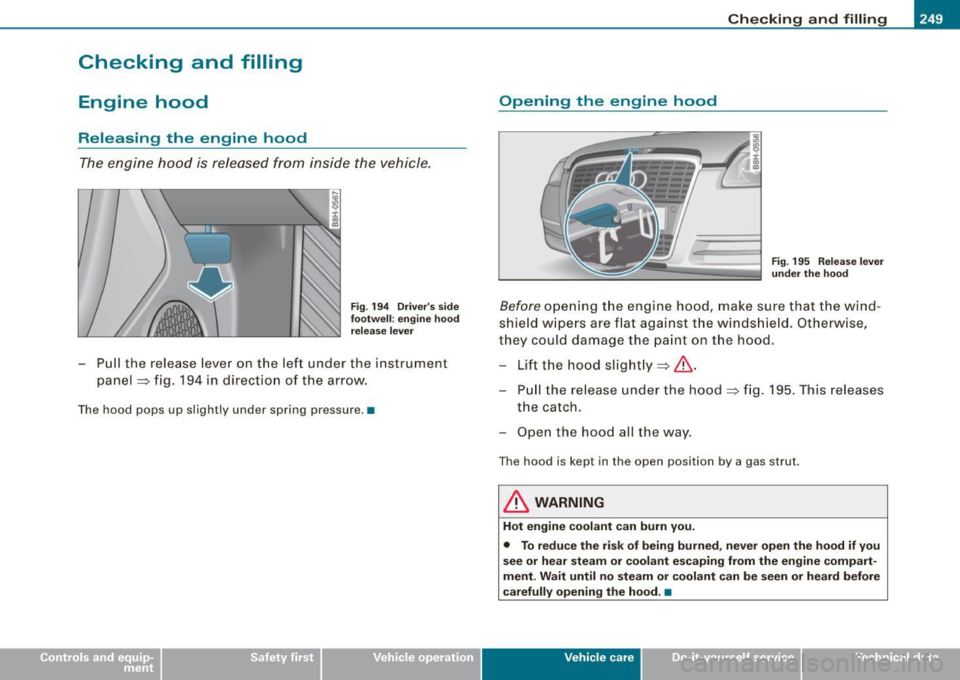
_____________________________________________ C_h_ e_ c _ k_in -= g_a _ n_d _ f_il _li _n """g ;;..._ ____.ffllll
Checking and filling
Engine hood
Releasing the engine hood
The engine hood is released from inside the vehicle.
Fig . 194 Driver's side
footwell: engine hood
release lever
-Pull the release lever on the left under the instrument
panel => fig. 194 in direction of the arrow.
The hood pops up slightly under spring pressure .•
Opening the engine hood
Fig. 195 Release lever
under the hood
Before opening the engine hood, make sure that the wind
shield wipers are flat against the windshield. Otherwise,
they could damage the paint on the hood.
Lift the hood slightly =>& .
- Pull the release under the hood
=> fig. 195. This releases
the catch.
- Open the hood all the way.
The hood is kept in the open position by a gas strut .
& WARNING
Hot engine coolant can burn you .
• To reduce the risk of being burned, never open the hood if you
see or hear steam or coolant escaping from the engine compart
ment. Wait until no steam or coolant can be seen or heard before
carefully opening the hood. •
Vehicle care irechnical data
Page 252 of 340
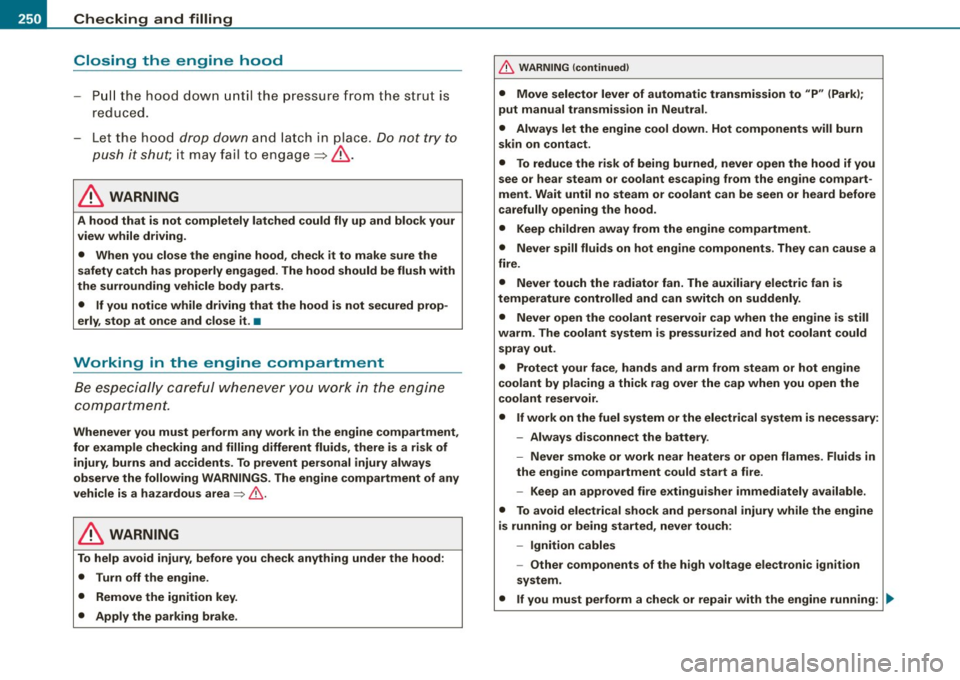
-~_C_ h_e _c _ k_ i_ n ...:::g:;..._ a_n_ d_ f_ i_ll _in ....;g:::;.._ ___________________________________________ _
Closing the engine hood
-Pull t he hood down until the pressure from the strut is
reduced.
- Let t he hood
drop down and latch in place. Do not try to
push it shut;
it may fai l to engage ~& .
& WARNING
A hood that is not completely latched could fly up and block your
view while driving.
• When you close the engine hood, check it to make sure the
safety catch has properly engaged. The hood should be flush with
the surrounding vehicle body parts.
• If you notice while driving that the hood is not secured prop
erly, stop at once and close it. •
Working in the engine compartment
Be especially careful whenever you work in the engine
compartment.
Whenever you must perform any work in the engine compartment,
for example checking and filling different fluids, there is a risk of injury, burns and accidents. To prevent personal injury always
observe the following WARNINGS. The engine compartment of any
vehicle is a hazardous area
~ 6 .
& WARNING
To help avoid injury, before you check anything under the hood :
• Turn off the engine.
• Remove the ignition key.
• Apply the parking brake.
& WARNING (continued)
• Move selector lever of automatic transmission to "P" (Park);
put manual transmission in Neutral.
• Always let the engine cool down. Hot components will burn
skin on contact.
• To reduce the risk of being burned, never open the hood if you
see or hear steam or coolant escaping from the engine compart
ment. Wait until no steam or coolant can be seen or heard before
carefully opening the hood .
• Keep children away from the engine compartment.
• Never spill fluids on hot engine components. They can cause a
fire.
• Never touch the radiator fan. The auxiliary electric fan is
temperature controlled and can switch on suddenly.
• Never open the coolant reservoir cap when the engine is still
warm. The coolant system is pressurized and hot coolant could
spray out.
• Protect your face, hands and arm from steam or hot engine
coolant by placing a thick rag over the cap when you open the
coolant reservoir.
• If work on the fuel system or the electrical system is necessary :
- Always disconnect the battery .
- Never smoke or work near heaters or open flames. Fluids in
the engine compartment could start a fire.
- Keep an approved fire extinguisher immediately available.
• To avoid electrical shock and personal injury while the engine
is running or being started, never touch :
- Ignition cables
- Other components of the high voltage electronic ignition
system.
• If you must perform a check or repair with the engine running:
~
Page 253 of 340
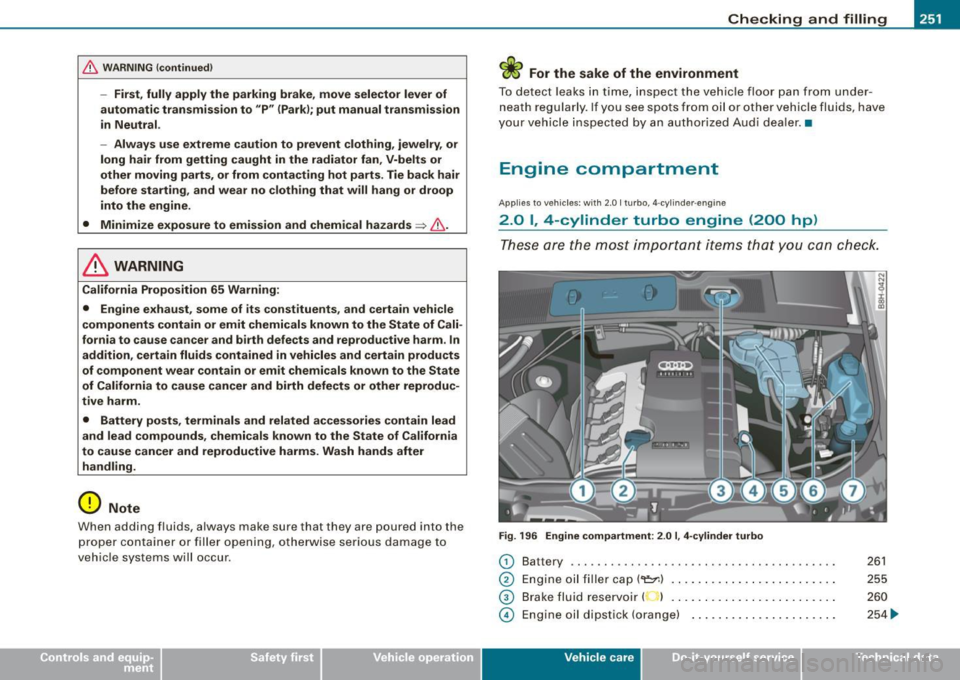
_____________________________________________ C_h_ e.::...::. c.:..k .:..in ;..:.:= g:.....:.; a.:..n :....:d ::....:. f.:.:il .:.:li .:..n :.::g:!-- ----J-
& WARNING (conti nued )
-First , fully apply the parking brake , move selector lever of
automatic transmis sion to "P " (Park) ; put manual transmiss ion
in Neutral.
- Always u se extreme caut ion to prevent clothing, jewelry , or
long hair from getting caught in the radiator fan, V-belts or
other moving parts , or from conta cting hot parts. Tie back hair
before starting , and wear no cloth ing that will hang or droop
into the engine.
• Minimize exposure to emission and chemical hazards
~ & .
& WARNING
California Proposition 65 Warning :
• Engine exhaust , some of its constituents , and certa in vehicle
components contain or emit chemicals known to the State of Cali
fornia to cause cancer and birth defects and reproductive harm . In
addition , certain fluids contained in vehicles and certain produ cts
of component wear contain or emit chemicals known to the State
of California to cause cancer and birth defects or other reproduc
tive ha rm .
• Battery post s, terminals and related acces sories contain lead
and lead compounds , chemicals known to the St ate of California
to cause cancer and reproductive harms. Wash hands after
handling.
0 Note
When adding f luids, always make sure that they are poured into the
p roper container o r filler opening, otherwise se rio us damage to
vehicle systems will occur .
W For the sake of the environment
To detect lea ks i n tim e, inspect t he v ehi cle floor pa n from u nde r
neath regularly. If you see spots from oil or other vehicle fluids, have
y o ur v ehicl e inspected by an author ized Au di dea ler. •
Engine compartment
App lies to veh icles: with 2 .0 I turbo, 4-cylinder •engine
2.0 I , 4-cylinder turbo engine (200 hp )
The se are th e m ost important items that you can check .
Fig. 196 Engine comp art m ent : 2 .0 I, 4-cy lind er turbo
G) Battery ..................................... •..
0 Engine oi l fi lle r ca p ('1:::r.l ..... ... ... ....... .... .. .
© Bra ke fluid reservoir ( ) ..... ... .... ... ... ... .. . .
© Engine oil dipstick (orange) ........ .......... ... .
Vehic le care
N
N
I
261
255
2 60
25 4 ...
irechnical data
Page 254 of 340
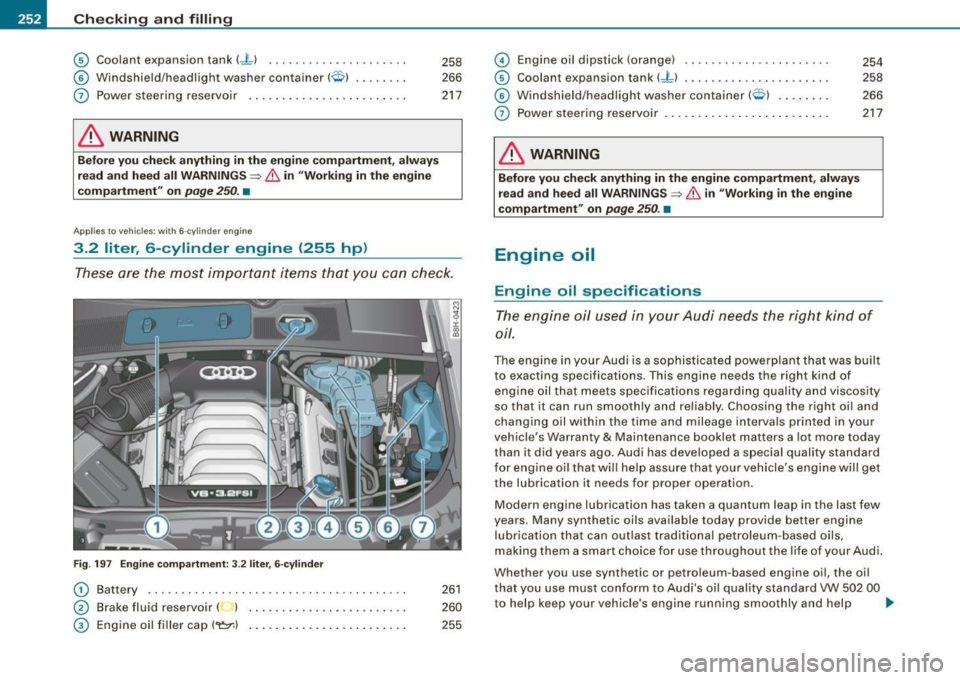
-Ch
ecking and filling
_ _..;:::;__=----------------
©
©
0
Coolant expansion tank (.J_ J .. .. .. .. . ... .. .. .... .
Windshield/head light washer container ( O ) ..... .. .
Po wer steering re servoi r
& WARNING
Before you check anything in the engine compartment , always
read and heed all WARNINGS
=> & in "Working in the engine
c ompartment " on
page 250. •
Applies to veh icles : w ith 6 ·cy lind er engine
3.2 liter , 6-cylinder engine (255 hp)
258
266
217
Th ese a re t he most im por tan t it em s th at you c an ch eck.
F ig . 197 Engine compartment : 3.2 liter , 6- cylinder
G) Battery ... ... .. ...... .... ... .... .... .... ..... .
0 Bra ke fluid reservoir ( l ....... .. .. .. .. ...... .. .
© Engine oil fi ller cap ('t:::n) ..•. ..• ..... .•. ...• ..•..
26 1
260
255
©
©
©
0
Engine oil dipstick (orange) ...... ..... ... .... ... .
Coolant expansion tank
( -L J .. ... ... . .... ... ... .. .
W indshield/headligh t washer c ontainer (O l .. .... . .
Powe r steering rese rvoir
& WARNING
Before you check anything in the engine compartment, always
read and heed all WARNINGS
=> & in "Working in the engine
compartmen t" on
page 250. •
Engine oil
Engine oil specifications
254
258
266
2 17
The engine oil used in your Audi needs the right kind of
oil.
The engi ne in y our Audi is a sophisticated powe rp lan t tha t was built
to exacting specifications. This engine needs the right kind of
eng ine oil that meets specifications regarding quality and viscos ity
so that it can run smoothly and reliably . Choosing the right oil and
changing oil within the time and mileage interva ls printed in your
vehic le's Warranty
& Maintenance booklet matters a lot more today
than it did years ago. Audi has developed a special quality standa rd
f or e ngin e oil tha t w ill help assure that your vehicle's engine will get
the lubrication it needs for proper operation.
Modern engine lubrication has taken a quantum leap i n the last few
years. Many synthetic oils ava ilable today provide better engine
lubrication that can o utlast traditional petro leum -based oil s,
making them a smart choice for use throughout the life of your Audi.
Whether you use synthetic or petro leum -based engine oil, the oi l
tha t you use mus t conform to Audi 's oi l qual ity standard VW 502 00
to help keep your vehicle's engine running smoothly and help ._
Page 255 of 340
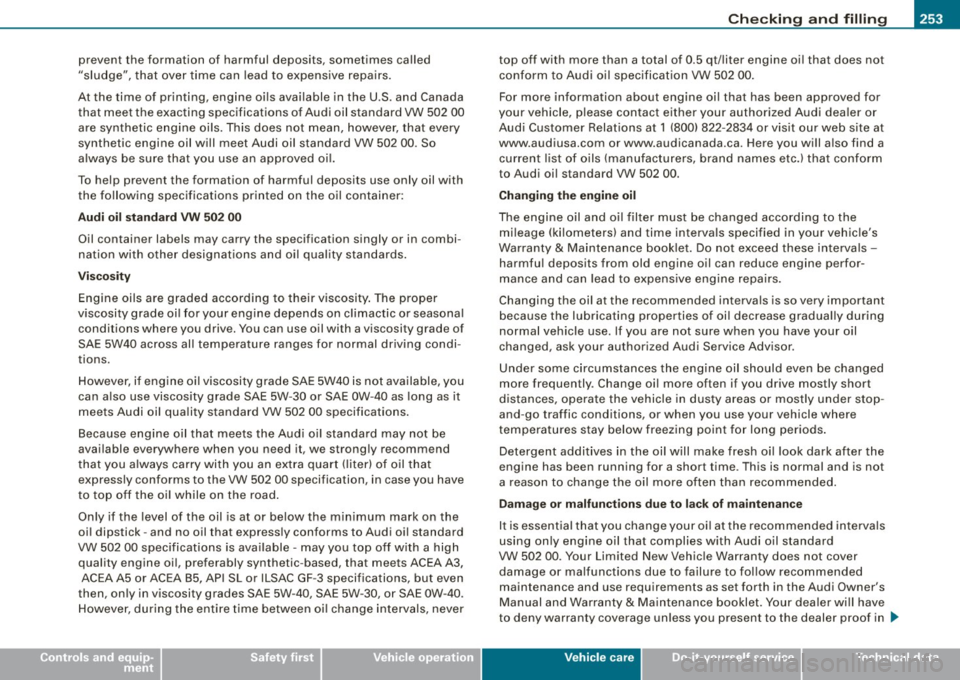
Checkin g a nd fillin g -
-----------------=-------"=--------
•
prevent the formation of harmful deposits, sometimes called
"sludge", that over time can lead to expensive repairs.
At the time of printing, engine oi ls available in the U.S . and Canada
that meet the exacting specifications of Audi oil standard VW 502 00
are synthetic engine oils. This does not mean, however, that every
synthetic engine oil will meet Audi oil standard VW 502 00. So
always be sure that you use an approved oil.
To help prevent the formation of harmful deposits use only oil with
the fo llowing specifications pr inted on the oil container:
A ud i oil stan dard VW 50 2 0 0
Oil container labels may carry the specification singly or in combi
nation with other designations and oil quality standards.
V isc osi ty
Engine oils are graded according to their viscosity . The proper
viscosity grade oil for your engine depends on climactic or seasona l
conditions where you drive. You can use oil with a viscosity grade of
SAE 5W40 across all temperature ranges for normal dr iving condi
tions.
However, if engine oil viscosity grade SAE 5W40 is not available, you
can a lso use viscosity grade SAE 5W-30 or SAE 0W-40 as long as it
meets Audi oil qua lity standard VW 502 00 specifications .
Because engine oil that meets the Audi oil standard may not be
avai lable everywhere when you need it, we strongly recommend
t hat you a lways carry with you an extra quart ( liter) of oil that
express ly conforms to the VW 502 00 specification, in case you have
t o top off the oil while on the road .
On ly if the level of the oil is at or be low the minimum mark on the
oi l dipstick -and no oil that express ly conforms to Audi oil standard
VW 502 00 specifications is available -may you top off with a high
quality engine oil, preferably synthetic -based, that meets ACEA A3,
ACEA A5 or ACEA B5, API S L or ILSAC GF -3 specifications, but even
then, on ly in viscosity grades SAE 5W -40, SAE 5W -30, or SAE 0W -40.
However, during the ent ire time between oi l change intervals, never top off with more than a total of 0
.5 qt/ liter engine oi l that does not
conform to Audi oil specification VW 502 00.
For more information about engine oi l that has been approved for
your vehicle, p lease contact either your authorized Audi dea ler or
Audi Customer Relations at 1 (800) 822-2834 or visit our web site at
www.audiusa.com or www.audicanada.ca. Here you will also find a current list of o ils (manufacture rs, brand names etc.) that confo rm
to Audi oil standard VW 502 00.
Changing th e engine oil
The engine oil and oil f ilter must be changed according to the
mi leage (ki lometers) and time intervals specified in your vehic le's
Warranty & Maintenance booklet. Do no t exceed these intervals -
harmfu l deposits from old engine oil can reduce engine perfor
mance and can lead to expensive eng ine repa irs.
Changing the oil at the recommended intervals is so very important
because the l ubricating properties of oi l decrease gradua lly during
norma l vehicle use. If you are not sure when you have your oil
changed, as k your authorized Audi Service Advisor.
Under so me circumstances the engine oil should even be changed
more frequently . Change oil more often if you drive mostly short
distances, opera te the vehicle in dusty areas or m ostly under stop
and-go traffic conditions, or when you use your vehicle where
temperatures stay below freezing point for long periods .
Detergent additives in the oil will make fresh oil look dark after the
engine has been running for a short time. This is normal and is not
a reason to change the oil more often than recommended.
D amag e or malf unct ions due to la ck of maintenan ce
It is essential that you change your oi l at the recommended intervals
using on ly engine oil that complies with Audi oil standard
VW 502 00. Your Limited New Vehic le Warranty does not cover
damage or malfunctions due to failure to fol low recommended
maintenance and use requirements as set forth in the Audi Owner's
Manual and Wa rranty & Maintenance booklet. Your dea ler wi ll have
to deny warranty coverage unless you present to the dealer proof in _,.
Vehic le care
Page 256 of 340
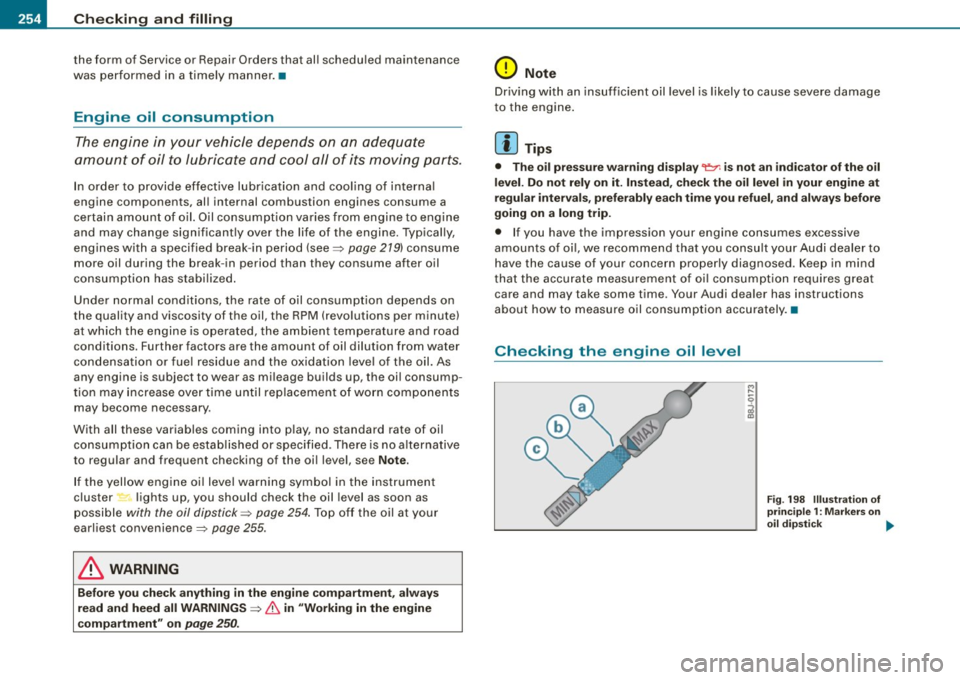
-~_C_ h_e _c _ k_ i_ n ...:::g:;..._ a_n_ d_ f_ i_ll _in ....;g:::;.._ ___________________________________________ _
the form of Service or Repair Orders that all scheduled maintenance
was performed in a timely manner. •
Engine oil consumption
The engine in your vehicle depends on an adequate
amount of oil to lubricate and cool all of its moving parts.
In order to provide effective lubrication and cooling of internal
engine components , all internal combustion engines consume a
certain amount of oil. Oil consumption varies from engine to engine
and may change significantly over the life of the engine. Typically,
engines with a specified break -in period (see~
page 219) consume
more oil during the break-in period than they consume after oil
consumption has stabilized.
Under normal conditions, the rate of oil consumption depends on
the quality and viscosity of the oil, the RPM (revolutions per minute)
at which the engine is operated, the ambient temperature and road
conditions. Further factors are the amount of oil dilution from water
condensation or fuel residue and the oxidation level of the oil. As
any engine is subject to wear as mileage builds up , the oil consump
tion may increase over time until replacement of worn components
may become necessary .
With all these variables coming into play, no standard rate of oil
consumption can be established or specified. There is no alternative
to regular and frequent checking of the oil level, see
Note.
If the yellow engine oil level warning symbol in the instrument
cluster lights up, you should check the oil level as soon as
possible
with the oil dipstick~ page 254. Top off the oil at your
earliest convenience~
page 255.
& WARNING
Before you check anything in the engine compartment, always
read and heed all WARNINGS
~ & in "Working in the engine
compartment" on
page 250.
0 Note
Driving with an insufficient oil level is likely to cause severe damage
to the engine.
[ i] Tips
• The oil pressure warning display 't!::r. is not an indicator of the oil
level. Do not rely on it. Instead, check the oil level in your engine at
regular intervals, preferably each time you refuel, and always before
going on a long trip.
• If you have the impression your engine consumes excessive
amounts of oil, we recommend that you consult your Audi dealer to
have the cause of your concern properly diagnosed . Keep in mind
that the accurate measurement of oil consumption requires great
care and may take some time . Your Audi dealer has instructions
about how to measure oil consumption accurately. •
Checking the engine oil level
Fig. 198 Illustration of
principle 1: Markers on
oil dipstick ..,_
Page 257 of 340
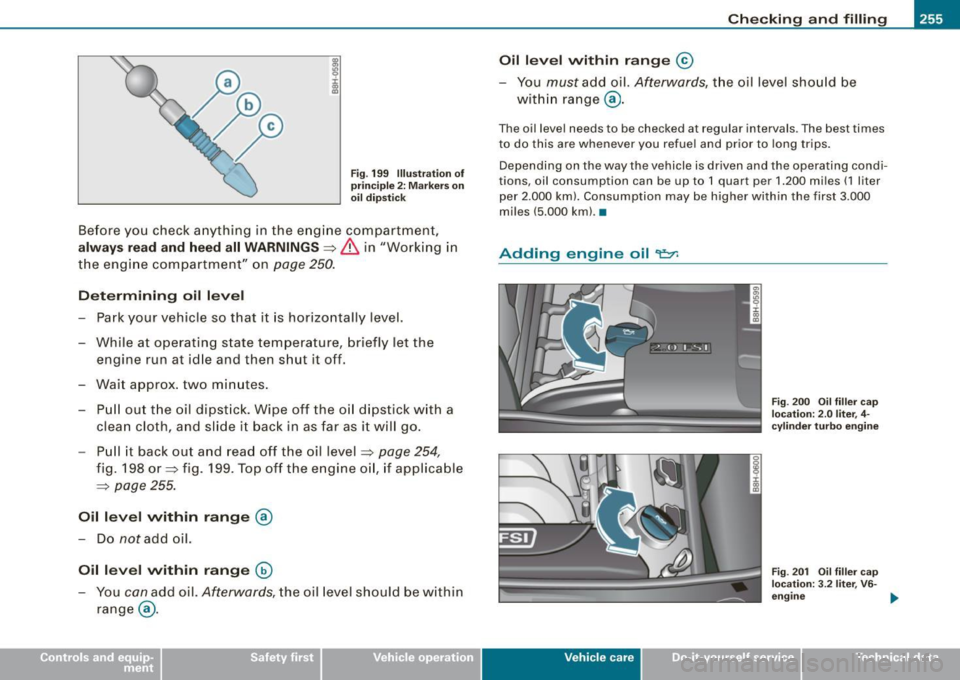
Checking and filling -_____________ _______::;____;;:;;____...j
Fig. 199 Illustration of
principle 2: Markers on
oil dipstick
Before you check anything in the engine compartment,
always read and heed all WARNINGS=> & in "Working in
the engine compartment" on
page 250.
Determining oil level
Park your vehicle so that it is horizontally level.
- While at operating state temperature, briefly let the
engine run at idle and then shut it off.
- Wait approx. two minutes.
- Pull out the oil dipstick. Wipe off the oil dipstick with a
clean cloth, and slide it back in as far as it will go.
- Pull it back out and read off the oil level
=> page 254,
fig. 198 or:::> fig. 199. Top off the engine oil, if applicable
=> page 255.
Oil level within range @
- Do not add oil.
Oil level within range G)
- You con add oil. Afterwords, the oil leve l should be within
range @.
Oil level within range ©
-You must add oil. Afterwords, the oil level should be
within range @.
The oil level needs to be checked at regular intervals . The best times
to do this are whenever you refuel and prior to long trips.
Depending on the way the vehicle is driven and the operating condi
tions, oil consumption can be up to 1 quart p er 1.200 miles (1 liter
per 2.000 km). Consumption may be higher within the first 3.000
miles (5.000 km). •
Adding engine oi l 'e::1':
Vehicle care
Fig . 200 Oil filler cap
loc ation: 2.0 liter, 4-
cylinder turbo engine
Fig . 201 Oil filler cap
location: 3.2 liter , VG-
engine _,,
irechnical data
Page 258 of 340
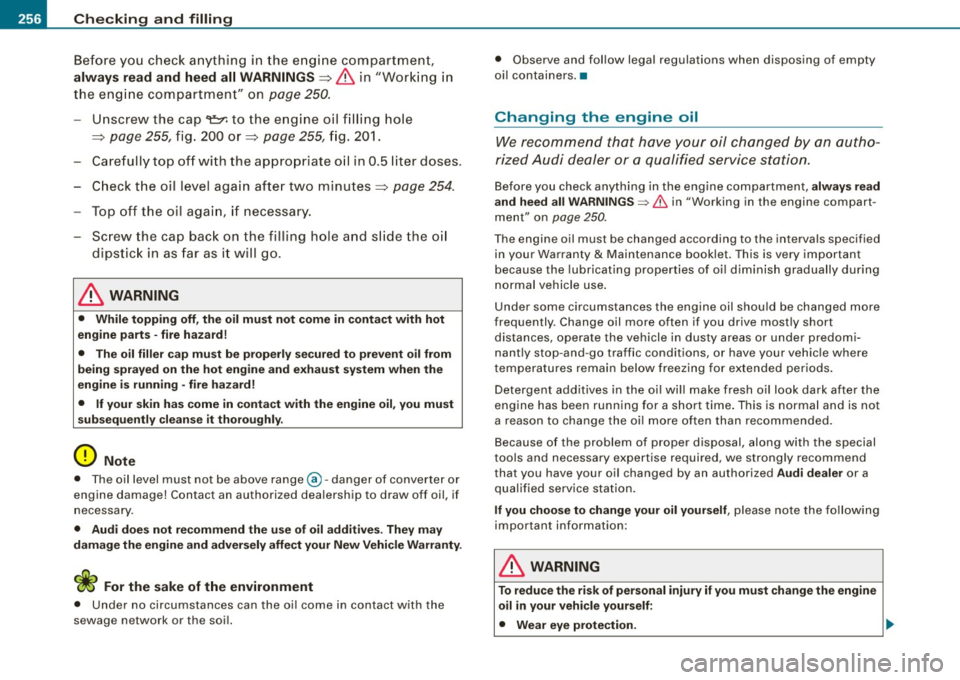
-~_C_ h_e _c _ k_ i_ n ...:::g:;..._ a_n_ d_ f_ i_ll _in ....;g:::;.._ ___________________________________________ _
Before yo u check a nything in the e ngine compartmen t,
always read and heed all WARNINGS~
& in "Working in
the eng ine compartment" on
page 250.
Unscrew the ca p~ to the e ngine oil filling hole
~ page 255, fig . 200 or~ page 255, fig. 20 1.
- Carefully top off wi th the appropriate o il in 0.5 liter doses.
- C heck the oil level aga in afte r two minutes ~
page 254.
-Top off t he oi l aga in, if necessary .
- Sc rew the ca p back on the fi lling h ole a nd s lide the o il
d ips tic k in as far as i t will go .
& WARNING
• While topping off , the oil must not come in contact with hot
eng ine part s -fi re hazard!
• The oil filler cap mu st be prope rly secured to prevent o il from
being spra yed on the hot engine and exhaust sy stem when the
engine i s runnin g -fire hazard!
• If your skin has come in conta ct with the engine oil , you mu st
s ub sequently clean se it thoroughly .
0 Note
• The oil level must not be above range@-danger of converter or
engine damage! Contact an authorized dealership to draw off oi l, if
necessary.
• Audi do es not recommend the use of oil additives . They may
d amage the engine and adver sely affe ct your New Vehicle Warr anty.
ffi For th e sake of the environment
• Under no circumstances can the oi l come in contact w ith t he
sewage network or the soil. •
Observe and follow legal regulations when disposing of empty
o il con tainers .•
Changing the engine oil
We recommend that have your oil changed by an autho
rize d Audi de aler or a qualified service s tation.
Before you check any thi ng in the engine compartment, alway s read
and heed all WARNINGS =>
& in "Working in the engine compart
ment" on
page 250.
The engine oil must be changed according to the intervals specified in you r War ranty
& Main tenance booklet . This is very important
because the lubricating properties of oil diminish gradually during
normal vehicle use .
Under some circumstances the engine oil shou ld be changed more
frequently . Change oil more often if you drive mostly short
distances, opera te the ve hicle in dusty areas or under predom i
nant ly stop -and -go traffic conditions, or have your vehicle where
t emperatures remai n below freezing fo r extended periods .
Detergent add it ives i n the oil wi ll make fresh oil look dark after the
engine has been running for a short time . This is norma l and is not
a reason to change the oi l more of ten than recommended.
Because of the problem of proper disposal, along with the special
t ools and necessa ry expert ise required, we strong ly recommend
that you have your oil changed by an authorized
Audi dealer or a
qual ified se rvice sta tion .
If you choo se to change your oil yourself , please note the follow ing
important information :
& WARNING
To reduce the risk of personal injury if you must change the engine
oil in your vehicle you rself:
• We ar eye protection . _.,
Page 259 of 340
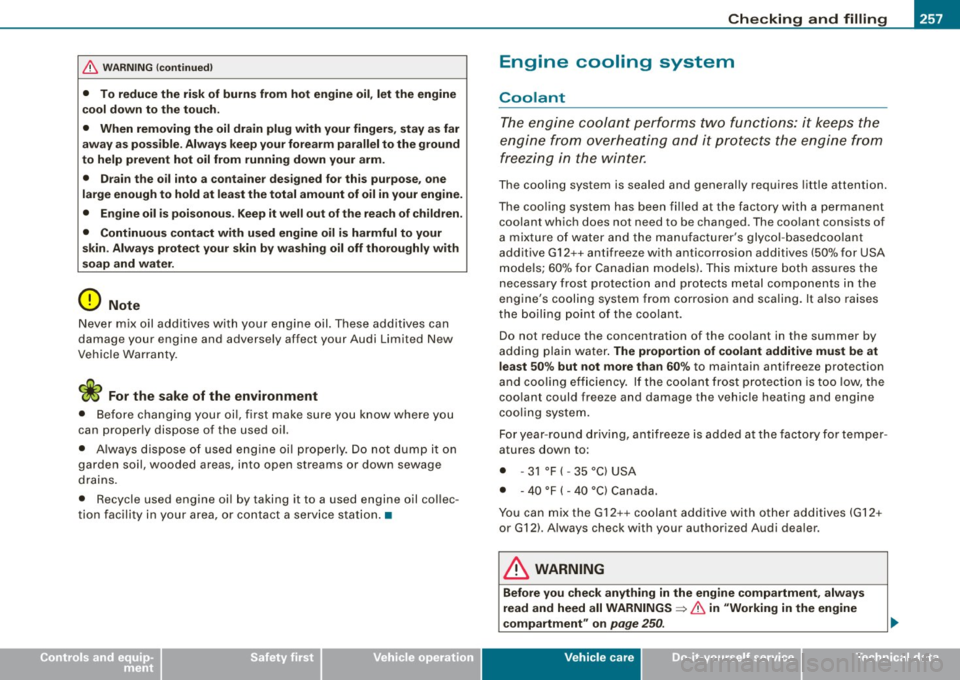
_____________________________________________ C_h_ e_ c_k _in ---= g'--- a_n _d_ f_il _li _n ....:g=-------"'
•
& W ARNING (conti nued )
• To reduce the ri sk of burns from hot engine oil , let the engine
c ool down to the tou ch.
• When removing the oil drain plug with your fingers , stay as far
a w ay as possible. Alway s keep your forearm parallel to the ground
to help prevent hot oil from running down your arm.
• Drain the oil into a container designed for thi s purpo se , on e
large enough to hold at least the total amount of oil in your engine.
• Engine oil is poisonous . Keep it well out of the reach of children .
• Continuous contact with used engine oil i s harmful to your
skin . Always prote ct you r skin by washing oil off thoroughly with
soap and water .
0 Note
Never m ix oil a ddi tives with yo ur engine oil. These additives can
damage your engine and adversely affect your Audi Limited New
Vehi cle Warranty.
~ For the sake of the environment
• Befo re c ha ng ing y our oi l, f irst make sure you k now w here y ou
can properly dispose of the used oil.
• Always dispose o f used e ngine oi l prop erl y. D o not dump i t on
garden soil, wooded areas, into open streams or down sewage
drains.
• Recycle used engine oi l by taking it to a used engine oil col lec
t ion facili ty in y our a rea, or co n tact a serv ice s ta tion .•
Engine cooling system
Coolant
T he e ngin e cool ant p erform s tw o functio ns: it k eep s th e
e ng ine f rom ov erh ea ting and it pro tects the engine fr om
freezing in the winter.
The cooling system is sealed and general ly requires little attention.
The coo ling syst em has been fil led at the fac tory with a perm an ent
coolant which does not need to be changed. The coo lant consists of
a m ix ture of wa te r and the manufacturer 's gl yco l- b ase dco olant
add it ive G 12++ antifreeze with anticorrosion additives (50% for USA
mode ls; 60% for Canadian mode ls) . T his m ixtu re bo th a ssure s the
n ecessary frost protectio n and p ro tects m etal co mponents in t he
eng ine's cooling system from co rrosion and scaling. It a lso raises
the boili ng poi nt o f the coolant.
D o not reduce the concentrat ion of the coo lant in the summer by
adding pla in wate r. The proportion of coolant additive must be at
least 50 % but not more than 60 % to maintain antifreeze protection
and coo ling eff iciency . If the c oolant frost p ro tecti on is t oo low, the
coo lant could freeze and damage th e vehic le heating and en gine
cool ing sy stem .
For year -rou nd driv ing, ant ifreeze is added at the facto ry fo r tempe r
atures down to:
• -31 °F ( -35 °C) USA
• - 40 °F ( - 40 °C) Canada.
You can mix the G12 ++ coolan t add itive with othe r additives (G12 +
or G12). A lways check wit h your authorized Audi dea ler.
& WARNING
Before you check anything in the engine co m partment , always
read and heed all WARNINGS
=> & in "Working in the engine
c ompartment " on
page 250 .
Vehic le care
Page 260 of 340

___ C_h_ e_ c_k _in --== g'-- a_n _d_ f_il _li _n ..::g=-- --------------------------------------------
0 Note
• Before winter sets in, have the coolant checked to see if the
coolant additive in your vehicle is sufficient to meet the climate
conditions. This is especially important if you live in a region where
the winter is extremely cold . If necessary, increase the proportion of
coolant additive to 60% .
• When adding coolant additive to your cooling system,
remember:
-We recommend using only coolant additive G12+ + (check the
label) for your vehicle. This coolant additive is available at autho
rized Audi dealers. Other types of antifreeze can significantly
reduce corrosion protection . The resulting corrosion can cause a
loss of coolant and serious engine damage.
• Do not add any type of radiator leak sealant to your vehicle's
engine coolant. Adding radiator repair fluid may adversely affect the
function and performance of your cooling system and could result
in damage not
covered by your New Vehicle Limited Warranty. •
Checking the engine coolant level
The engine coolant level can be checked with a quick
glance.
Fig . 202 Engine
compartment: Coolant
expansion tank
Before you check anything in the engine compartment,
always read and heed all WARNINGS~ & in "Working in
the engine compartment" on
page 250.
Turn off the ignition.
- Let the eng ine cool down.
Place a thick rag over the coolant expansion tank
~ fig. 202 and carefully twist the cap counter-clockwise
~& .
Read the engine coolant level in the open coolant expan
sion tank~ fig. 202. With a cold engine, the coolant level
should be between the "min" and "max" markings. When
the engine is warm, the level may be slightly above the
"max" marking .
The location of the coolant expansion tank can be seen in the
engine compartment illustration=>
page 252.
To obtain an accurate reading , the engine must be switched off .
The expansion tank in your vehicle is equipped with an electric
coolant level sensor.
When the coolant l evel is too low, the warning light in the Auto
Check System :::::,
page 31 will blink until you add coolant and the
level has been restored to normal. Even though there is an electric
coolant level sensor, we still recommend you check the coolant level
from time to time .
Coolant loss
Coolant loss may indicate a leak in the cooling system. In the event
of coolant loss, the cooling system should be inspected immedi
ately by your authorized Audi dealer . It is not enough merely to add
coolant.
In a
sealed system, losses can occur only if the boiling point of the
coolant is exceeded as a result of overheating. ..,.